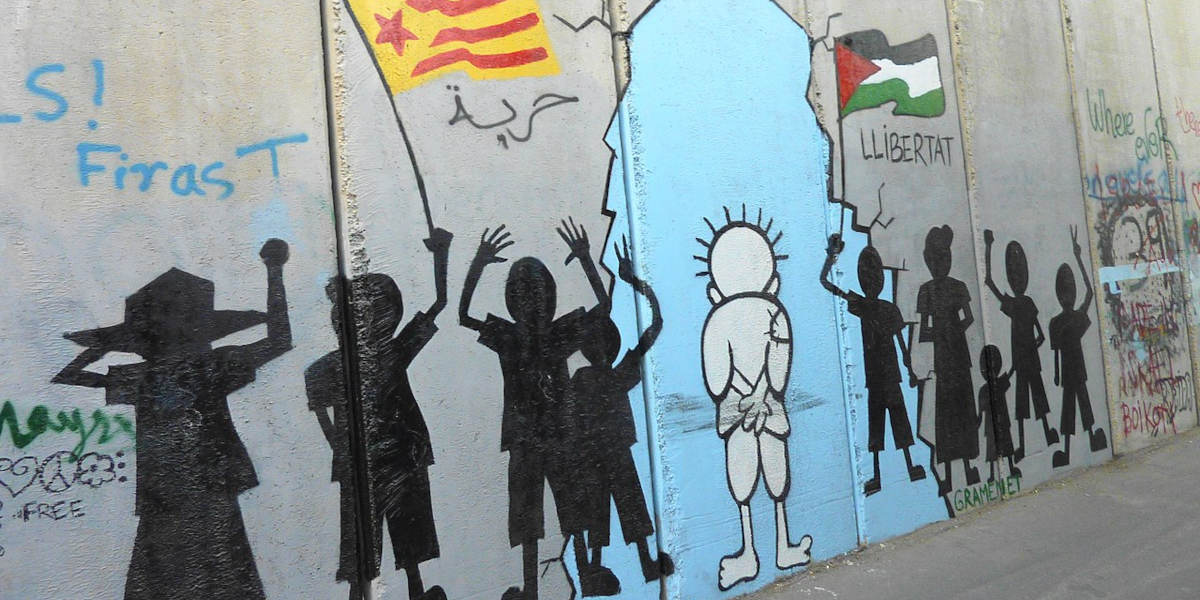Title: A Child in Palestine: The Cartoons of Naji al-Ali
Authors: Naji al-Ali, introduced by Joe Sacco
Publisher: Verso
Year: 2024
I don’t remember the first time I saw an image of Handala, or when it was explained to me who Handala is or what he represents. It’s one of those things most Palestinians grow up seeing and knowing – an awareness both inherent and inherited.
Created by Naji al-Ali in 1969, the cartoon of Handala depicts a barefoot child with his hands behind his back in defiance. Handala is known, in Palestinian popular culture, to be forever 10 years old – the age of al-Ali when his family was forcibly expelled during the 1948 Nakba.
Today, Handala remains a fundamental symbol of Palestine and of Palestinian exile. Once you recognise the cartoon, you see it everywhere: keychains, t-shirts, laptop cases, necklaces, and phone covers. The character has become popularised to the extent that sometimes I fear it has lost its political and revolutionary meaning. Verso’s re-publishing of A Child in Palestine: the Cartoons of Naji al-Ali reminds us of the political weight of al-Ali’s work.
A journey through a cause
The book is divided into five sections: Palestine; Human rights; US dominance, oil and Arab Collusion; The peace process; and Resistance. The cartoons are thus presented in a way that takes us through the complexities of the Palestinian cause.
The first section sheds light on the material conditions of the Palestinian people. Al-Ali’s cartoons visualise what it means to be Palestinian. Handala observes the reality of our condition of exile and imprisonment, and the cartoons embody Palestinian collective feelings of displacement and entrapment.
Al-Ali then turns to themes of political repression and oppression by ruling classes and reactionary forces, including Zionism, the US and Arab regimes. Someone who is new to or reduces the Palestinian cause to an ‘Arab-Israeli conflict’ would likely find these cartoons surprising. However, anyone familiar with the Palestinian leftist tradition understands that there are three enemies of the Palestinian people: Zionism, Arab reactionaries and world imperialism.
All three of these enemies, and their entanglement, are captured in this section. Since the signing of the Oslo Accords, the human rights framework has de-politicised the Palestinian struggle, framing it as a humanitarian issue rather than a political project for national liberation. The naming of this section ‘Human rights’ does a disservice to the political nature of the cartoons and our liberation struggle at large.
‘US dominance, oil, and Arab collusion’ articulates the history of the Zionist-imperialist alliance and their military, political, and economic entanglements. The section builds concretely from the previous one, insisting that the Palestinian people will not be free without the dismantling of Zionism, imperialism and Arab reactionary forces.
‘The peace process’ articulates the political instruments that enabled the enemies of the Palestinian people to further their own interests. Specifically, these cartoons expose the facade of the Oslo and Camp David accords – each of which were only made possible because of the alliance between Zionism, western imperialism and the Arab bourgeoisie. Similarly, the cartoons specifically name UN resolutions 242 and 338, questioning the legitimacy and effectiveness of international bodies and instruments, which perhaps resonates more than ever as we see the negligible impact of the International Court of Justice on the ongoing genocide in Gaza.
The final section honours enduring Palestinian resistance in the face of attempts at capitulation. Despite being confronted by forces that far outweigh them economically and militarily, al-Ali leaves us with the promise of Palestinian liberation and instructs us on what it will take: insurgency, refusal and struggle. Such notions have never been more pertinent as the Palestinian people continue to resist and refuse defeat.
Timely yet timeless
A theme peppered throughout the book is the Arab dimension of our struggle, particularly the centrality of Lebanon, where al-Ali was raised in the refugee camps. These references remind us that the 1982 invasion of Lebanon changed the course of our struggle forever and honour the ongoing role of Lebanese resistance in the Palestinian liberation struggle.
A Child in Palestine could not be more timely in its re-release, reminding us of the historical roots of the enduring resistance of the Palestinian people. But the book is also timeless. In the face of Zionist historical revisionism and liberal attempts to deem our struggle ‘too complicated’, al-Ali’s cartoons simply and clearly eternalise our history and honour our truth. Handala will continue to be relevant as a historical record and living archive, even after Palestine is, eventually but surely, free.











